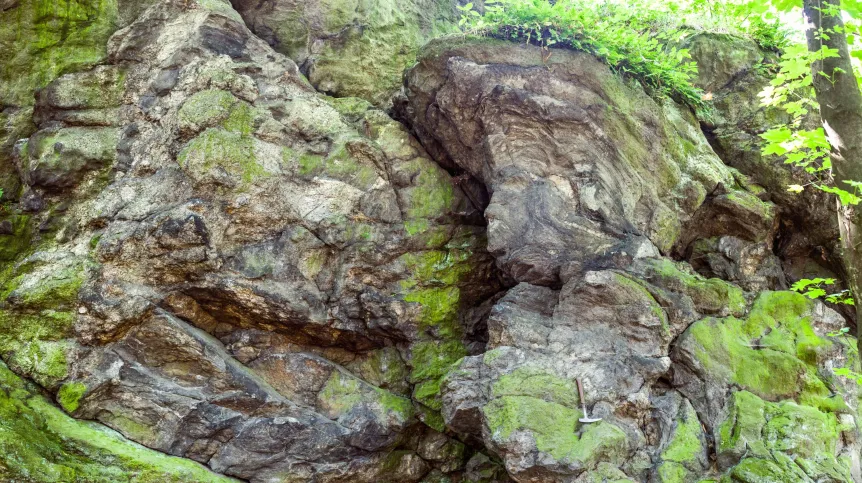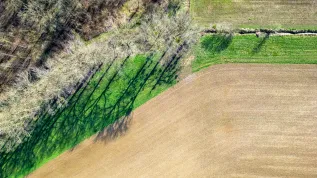
The gneisses of the Strzelin massif are probably the oldest surface rocks in Poland. However, there are still rocks in the country whose exact age is unknown, says Mateusz Szadkowski from the Lower Silesian Branch of the Polish Geological Institute-NRI.
The Strzelin massif is located in the eastern part of the Fore-Sudetic Block. Geographically, it is the eastern part of Sudeten Foreland, specifically the Strzelińskie and Lipowe ranges. The oldest varieties of gneisses of the Strzelin massif are the Strzelin gneisses (568-600 million years old) and Nowolesie gneisses (575-602 million years old). The latter can be admired in the place called Skalice Rocks. It was here that scientists observed various types of deformation structures in the gneisses, which helped to reconstruct the history of their formation.
'It is an extremely interesting place from a scientific point of view, but also an interesting tourist destination', says Mateusz Szadkowski from the Lower Silesian Branch of the Polish Geological Institute - National Research Institute in Wrocław. It is located in the area of the Sudeten Foreland Geopark, in Skalice, about 3 km from the famous monastery in Henryków, where the Book of Henryków was created - a chronicle containing the first written sentence in Polish.
The Strzelin massif is built of various metamorphic (transformed) rocks, mainly types of gneisses. 'Gneiss is a specific rock that can be formed from both igneous and sedimentary rock, and its external appearance does not necessarily reveal its origin', says Mateusz Szadkowski.
Visually, gneisses can be very different from each other. However, as the geologist explains, their common, distinguishing feature is that the components of such a rock (minerals), are arranged in an orderly manner, in a certain direction, not chaotically. 'It can look like fine streaks or very distinct layers. However, this feature allows us to distinguish between gneiss and, say, granite', he describes.
The Strzelin massif is also built of other types of gneiss, schist and other metamorphic rocks, the youngest of which are about 400 million years old. However, the Strzelin massif is most famous for its igneous rocks - granites, mined in Strzelin and the surrounding towns. These rocks are around 300 million years old.
How do we know that the Strzelin gneisses are probably the oldest rocks in Poland? 'The matter is not simple, because, as you can easily guess, there is no ranking of the oldest rocks in Poland to refer to', admits Szadkowski. 'There are still rocks in Poland, the exact age of which we do not know'. This is due to the fact that they were studied in detail quite a long time ago, when there were no precise dating techniques, and no one has revisited this topic. 'Or they are simply quite difficult to date, because they do not contain any fossils or minerals enabling effective isotopic dating', adds the geologist.
Initially, in a scientific paper from 2003, the oldest gneisses from the Strzelin massif were dated at 1 billion 20 million years old. 'From later papers (2009 and 2010) we learn that they are actually almost half as old, around 600 million years old', the geologist says. He explains that the difference is only due to the fact that a slightly different method was used, based on more precise research equipment. He explains that in order to find out which rock is the oldest, one has to go through numerous scientific papers and compare the dating of different rocks, made by different geologists and at different times.
How were these oldest rocks in Poland formed? 'We have to realize that 600 million years ago the world looked very different from the world we know today. The distribution of continents on our planet was different, and there was no such thing as Europe at all', describes the geologist. He reminds that only its north-eastern part (called Baltica) existed and it was located in the southern hemisphere.
A large part of the globe was occupied by the huge supercontinent Gondwana. 'It consisted of today's South America, Africa, Asia, Australia and Antarctica, so it was really large', the scientist describes. 'And it was on this huge continent, about 600 million years ago, that the rocks we are talking about, still granites then, were formed'.
More than 100 million years later, relatively small fragments called microcontinents began to break away from Gondwana. One of such microcontinents, which later merged with Baltica, contained the aforementioned granites. Later, another fragment broke away from Gondwana, containing a lot of rocks we know from the area of today's Sudetes, including the Strzelin massif. 'These are the younger gneisses, about 500 million years old', adds the geologist.
When these microcontinents merged approximately 350 million years ago, the two groups of rocks, originally belonging to two different fragments of the Earth's crust with different histories, ended up right next to each other. 'This is exactly what we observe in the Strzelin massif, as well as in the Eastern Sudetes in Czechia', says Szadkowski. 'The discovery of this specific situation in the Strzelin massif was possible thanks to detailed studies of the gneisses'.
The gneisses of the Strzelin massif were studied from very different angles and with different methods. 'First of all, it was important to study zircons, minerals that, while they are scarce in rocks, provide a lot of important information. Thanks to them we know the age of these rocks, and more precisely thanks to isotopic studies (U-Pb method)', explains Szadkowski.
Based on zircon studies, it was possible to determine that these rocks must have formed on two completely different microcontinents, or tectonic microplates. 'Zircons are very specific minerals, they can withstand a lot. For example, they can survive even if the rock, in which they were formed, ceases to exist', the geologist explains. 'Then they end up in another rock, but they carry information about the time of formation of the previous one'.
'We call this information inherited ages. If we compare the inherited ages of the various types of gneisses in the Strzelin massif, it turns out that they are different', says Mateusz Szadkowski. This, in turn, confirms that these gneisses formed in the vicinity of completely different rocks, in other words, rocks that are currently next to each other have completely different histories. At the same time, they can be compared with rocks from various parts of Poland or Europe, and on this basis it is possible to determine to which of the former microcontinents they belong.
'Regarding the gneisses of the Strzelin massif, the study of structures formed during the deformation of rocks, i.e. when the former continents collided, is particularly interesting', says Szadkowski. 'We can read from these structures, for example, in which direction the rocks moved over each other, or that first they were deeply embedded in the Earth's crust, and then resurfaced to smaller depths'.
Rocks are divided into three main groups: igneous, sedimentary and metamorphic. Igneous rocks are formed by the solidification of magma, whether on the Earth's surface (extrusive/volcanic rocks) or deep underground (intrusive rocks). Sedimentary rocks are formed by the accumulation of sediments, such as rock fragments or salt crystals precipitated from water. The third type are metamorphic rocks.
'Their formation is probably the most complicated, because there must be some primary rock, usually igneous or sedimentary, which transforms under the influence of factors such as pressure and temperature (e.g. at great depth in the Earth's crust) and becomes a metamorphic rock', the geologist describes.
Szadkowski concludes that science is moving forward all the time and 'it may soon turn out that we learn something completely new about rocks that have already been studied'. (PAP)
PAP - Science in Poland, Anna Mikołajczyk-Kłębek
amk/ agt/ kap/
tr. RL













